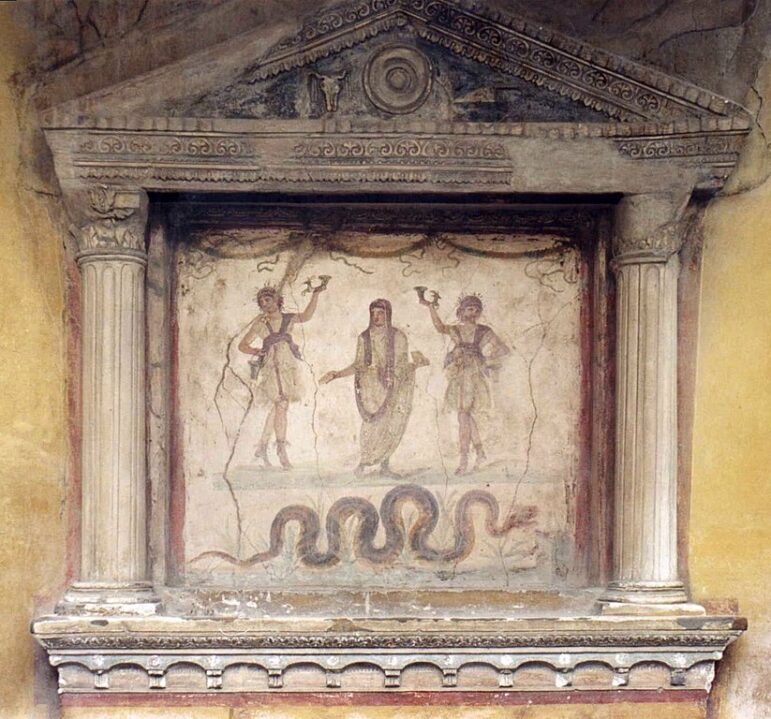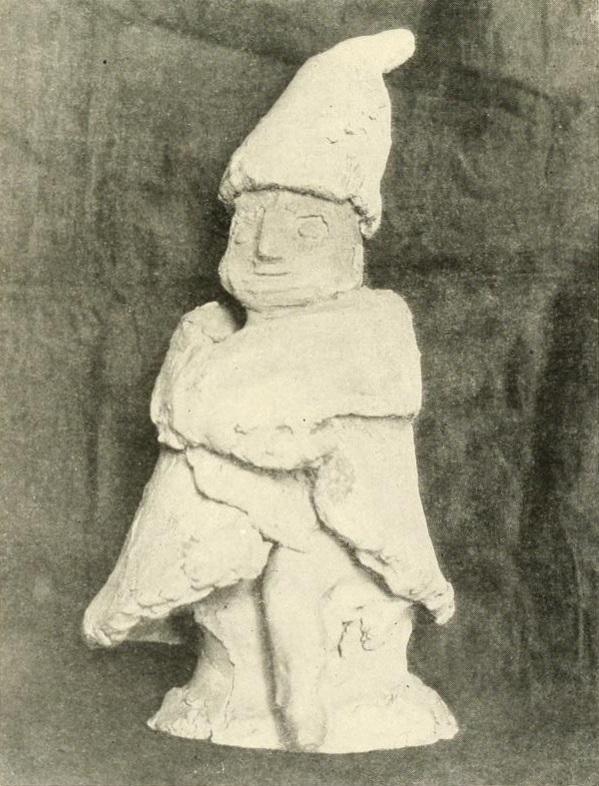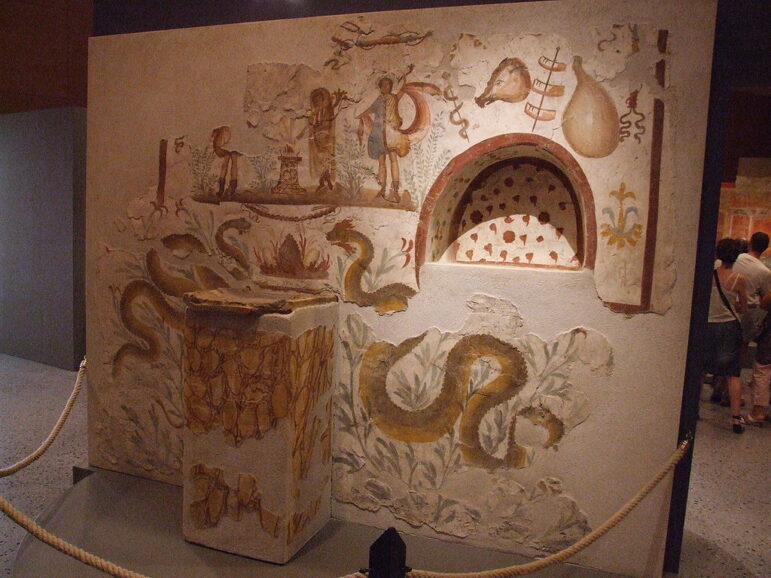
Today’s offering comes to us from SianLuc Asha Merlyn Heart, an amateur scholar in anthropology and history, interested in the history of religion and studying to become a scholar in religious history and theology at the University of New England, Australia.
The altar serves as one of the focal points of private devotion among Pagans in the modern day. In any space dedicated to the discussion of contemporary Paganism by Pagans, it does not take long for people to start talking about, and sometimes sharing images, of their altars, most often their personal working altars. But with how varied and inconsistent the rules and uses of altars can be, one has to wonder whether this common practice was really part of the religions of antiquity, or whether personal altars are an invention of the modern day.
To begin with, a small definition of what an altar is and the kind of altar being reviewed must be offered. For our purposes, an altar is a table or platform that serves as a space for holding offerings, sacrifices, or serves any other religious function. A personal altar is most commonly found in the home and is utilised by an individual for their private religious practices and devotion.
With that, this walkthrough of historical altars shall begin. To start with something familiar, Roman Pagans utilised what is known as a lararium. These served as altars to worship and give offerings to the Lares, who are the deities of the home. It may have also been utilised to worship the gods of the family and the ancestors.

First-century Roman Lararium from the House of the Vettii in Pompeii. [Wikimedia Commons, Patricio Lorente, CC 2.5]
The lararium was made near the hearth and could be found in the form of a cabinet, shelf, or a structure further made into the wall. It was at times decorated with mural art, showing the Lares and other spiritual elements. The most famous lararium would be the Lararium of Pompei, where the two Lares were accompanied by a serpent. An interesting thing to note is the tools of the Lararium, which could include salt containers, incense burners, a sacred lamp, and a place to hold libations and burn incense.
In Ancient Egypt, since the New Kingdom period, most homes held a personal altar. This space was maintained by women. They held statues of the personal deity of the family and home, the images of their ancestors, and a long list of amulets that could include Renenutet, Twaeret, Bes and Bastet. On these altars, libations, flowers and food offerings were given by the family to the deities much in the same manner that other more public cults would.
More physical altars such as these can be found in other modern religions as well. In both Chinese folk religion and Shinto, personal altars can be found, used according to their own customs and rules. An example closer to the Roman instance would be the organisation of the Chinese altar. Here the altar serves as a place of unity for the family, with the altar presenting the depictions of the ancestors and ancestral tablets and acting as a place to burn incense and give offerings to them.
Shinto, however, is a different case. Here the altar serves for one’s devotion to a divine entity called a kami. They are made with a kamidama which have to be specially made in a Shinto shrine and display a Shintai or a charm in which the kami is thought to inhabit. Further it was a requirement for the personal altar to be displayed upon a shelf that was found above the eyeline to demonstrate the difference between worshiper and god.

Statue of Domovoy from Silesia, 1918 [Jan Máchal, public domain]
The use of unusual or already existing spaces in the household as a personal altar can also be found in Rodnovery. Here the worship of the Domovoy serves as the deified form of the progenitor of the family and is represented as a clay figure who is then placed on the niches around doors or above the hearth. From these positions the Domovoy is given food offerings or even sacrifices from the family, and when they would move they would do special rites to bring the Domovoy from the old house into the new one.
Similarly, the Scandinavian Nisse was thought of as being the spirit of the first person to own the farm or build the house and the rites involving them would include worship at their burial mound. This practice continued until the Christianization, where the practice was demonized and attacked by multiple Christian figures, including Saint Birgitta who warned men against worshiping “Tomte gods.” (Tomte was another name for the Nisse.)
The cult of the hearth was by far the most common form of personal worship space. This can be seen amongst the ancient Celts in particular. This can be especially seen in the design of the hearth, with the firedogs being designed to represent sacrificial animals such as rams or bulls with flower crowns or the base of the hearth having intricate and beautiful designs.
This can also be found in modern Celtic culture from Scotland and Ireland. In folk belief it is held to be important to keep the hearth lit all year round until Beltane, where they were allowed to go out and then lit again with the fire of Uisneach. Additionally, the house gods of the Celts, the brownies, are especially honoured with offerings of milk and food left on the altar and the fairies were thought of as sitting by the hearth during the night.
This cult of the hearth can be seen in other ancient cultures as well. Among the Greeks and the Romans it was common to worship the goddess in the form of the hearth fire and consider the element sacred, as can be seen with this quote:
‘Vesta is the same as the earth, both have the perennial fire: the Earth and the sacred Fire are both symbolic of home.’ – Ovid, Fasti 6, 269-70
This is true for a score of other traditions, such as Gabija, who persists in Baltic and Slavic traditions. In much the same way as Gaelic households do, the fire would be smoored every night and given offerings of bread, salt and water by the household.

A household lararium from Pompeii [Claus Ableiter, Wikimedia Commons, CC 3.0]
This practice can also be found in the modern religion of Zoroastrianism. Here the fire of the household was known as Atash Dadgah, found either in a hearth or in a special cup-like container, and kept lit by the household as an unconcentrated fire. In the faith, fire serves as a focal point of religious worship, being found not only inside the home but in temples and other sites of religious importance where it is kept constantly lit.
The hearth cult demonstrates one of the most important but forgotten parts of ancient pagan domestic worship. It can be difficult in the modern day to keep a hearth lit, or even to find a house with a hearth. However the method of containing a personal fire in Zoroastrianism does give some glimpse of a compromise or other method rather than going directly to the greater hearth. Hopefully one day the practice will make a complete return.
This review has touched upon many ancient cultures and religions and gives a wide range of answers on how the personal altar was created and came to be. Hopefully one day the household altar becomes common place yet again with whatever form it used to take.
The Wild Hunt is not responsible for links to external content.
To join a conversation on this post:
Visit our The Wild Hunt subreddit! Point your favorite browser to https://www.reddit.com/r/The_Wild_Hunt_News/, then click “JOIN”. Make sure to click the bell, too, to be notified of new articles posted to our subreddit.